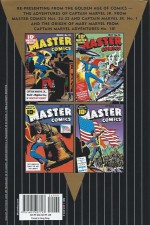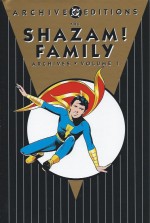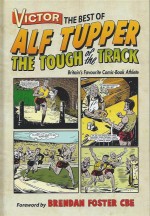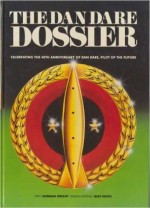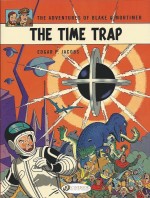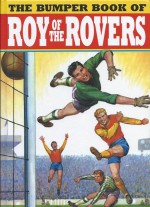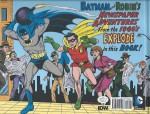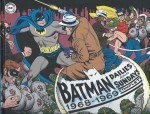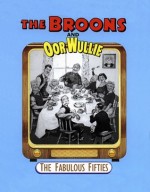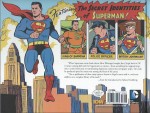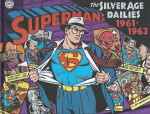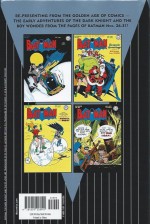
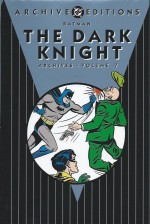
By Bob Kane, Don Cameron, Bill Finger, Joe Samachson, Jack Schiff, Alvin Schwartz, Joe Greene, Dick Sprang, Jerry Robinson, Jack Burnley & various (DC Comics)
ISBN: 978-1-4012-2894-1
Win’s Christmas Recommendation: Classically Traditional, Timelessly Wonderful… 9/10
Launching in 1939, a year after Superman, “The Bat-Man†(and latterly Robin, the Boy Wonder) cemented DC/National Comics as the market frontrunner and conceptual leader of the burgeoning comicbook industry.
Having established the fantastic parameters of the metahuman with their Man of Tomorrow, the strictly mortal physical perfection and dashing derring-do of DC’s Dynamic Duo rapidly became the swashbuckling benchmark by which all other four-colour crimebusters were judged.
This seventh lavish hardback Archive Edition volume covers another bombastic bevy of Batman adventures (from #26-31 of his solo title, spanning December 1944/January 1945 to October/November 1945), abandoning wartime themes and exploits as the American Homefront anticipated a return to peacetime dangers, dooms and criminality….
These Golden Age tales are amongst the very finest in Batman’s decades-long canon as lead writers Bill Finger and Don Cameron, supplemented by Joe Samachson, Jack Schiff, Alvin Schwartz, Joseph Greene and other sadly unrecorded scripters, pushed the boundaries of the medium whilst graphic genius Dick Sprang veteran gradually superseded and surpassed originator Bob Kane (busy drawing the Batman daily newspaper strip); making the feature utterly his own whilst keeping the Dauntless Double-Act at the forefront of the legion of superhero stars.
The sheer creativity exhibited in these adventures saw an ever-expanding band of creators responsible for producing the stories of the Dark Knight were hitting an artistic peak which only stellar stable-mate Superman and Fawcett’s Captain Marvel could match.
Following a fascinatingly fact-filled and incisive Foreword from comics historian – and leading light of the magnificent Grand Comics Database – Gene Reed, the mesmerising flash and dazzle commences with Batman #26 and ‘The Twenty Ton Robbery!’
Delivered by Cameron & Sprang it described the return of Dashing Desperado The Cavalier, whose criminal cries for attention drove him to compete against the Caped Crusaders with ever-more spectacular and pointless plunderings after which Schiff & Robinson proffered another delightfully silly comedy-caper in ‘The Adventures of Alfred: Recipe for Revenge!’
This solo exploit of the wannabe detective found the fumbling footman shopping for fancy cuisine and inadvertently saving the life of a gourmet chef…
Crafted at the end of 1944, Greene & Sprang’s ‘The Year 3000!’ was a timely allegory of recent terrors and warning to tomorrow as the usual scenario boldly switched to an idyllic future despoiled when the Saturnian hordes of Fura invade Earth and nearly crush humanity. Happily, one brave man and his young friend find records of ancient heroes named Batman and Robin and, patterning themselves on the long-gone champions, lead a rebellion which overturns and eradicates those future fascists…
Although a touch heavy-handed in places, this first conception of the undying legacy of Batman is a stunning example of what comics do best: inspire whilst entertaining…
Cameron & Sprang close up the issue, back on solid ground and with an eye to contemporary trends as ‘Crime Comes to Lost Mesa!’ finds the Gotham Gangbusters way out west in pursuit of escaped convicts and stumbling into a lost land where pueblo Indians still live in blissful ignorance of the modern world.
Keeping it that way takes the aid of plucky native tyke Nachee, helping Batman and Robin by surreptitiously rounding up the fugitives…
Issue #27 sported a stunning Christmas cover by Jack Burnley (equally captivating other covers in this collection are provided by Robinson or Sprang) before the Masked Manhunters were introduced to ‘The Penguin’s Apprentice’ (Cameron, Burnley & Robinson). The lad was far from keen to continue the family’s illegal traditions or indulge in nefarious business and his dreams of being an author soon ensured Batman put the Bird Bandit back in a cage…
Jerry Robinson always had a deft touch with light comedy and excelled in illustrating the sadly uncredited butler yarns remaining in this tome. ‘The Adventures of Alfred: The Pearl of Peril!’ saw the hapless manservant suckered into an ancient con-game but still coming up trumps thanks to sheer dumb luck, after which Samachson, Burnley & Robinson took Batman and Robin on a ‘Voyage into Villainy’ when a murder at The Explorers Club leads to a deadly treasure hunt through scaled-down replicas of Earth’s most inhospitable environments with a hidden killer waiting to pounce at any moment…
Another of the annual “Christmas Batman†tales wraps up the issue (why on Earth DC has never released a paperback collection of this phenomenally rich seam of Festive gold I’ll never understand) as ‘A Christmas Peril!’ by Cameron & Robinson follows the downward progress and overnight redemption of appallingly callous boy-millionaire Scranton Loring, who learns – almost too late – the joy of giving and inadvisability of trusting bankers and financial advisers, thanks to the timely intervention of a couple of self-appointed (masked) Santa’s Helpers…
Batman #28 leads with ‘Shadow City!’ (Cameron & Robinson) wherein The Joker concocts a wild scheme involving a floating urban street where gamblers and other wealthy risk-takers can indulge their dark passions safe from legal oversight – until the Dynamite Detectives deduce the truth of his vanishing village…
Another anonymous Robinson-rendered romp follows as ‘The Adventures of Alfred: The Great Handcuff King!’ reveals how the bumbling butler’s attempts to familiarise himself with manacles accidentally ensnares an unwary thuggish miscreant, after which the mild-mannered manservant almost ends the career of ‘Shirley Holmes: Policewoman!’ by inadvertently exposing the undercover cop to criminals in a tense Batman thriller by Finger & Robinson.
This issue ends on a redemptive high note as ‘Batman Goes to Washington!’ (Alvin Schwartz & Robinson) finds the Dark Knight supporting a group of former criminals heading to the nation’s capital to argue the case for jobs for ex-offenders. Typically, some gang bosses react to the threat to their potential labour pool with murderous overkill…
Finger & Sprang opened #29 with the chilling ‘Enemy No. 1’ as a man obsessed by being first at everything turned his monomaniacal frustration to the commission of crime, after which the Unknown Writer joined Robinson returned in ‘The Adventures of Alfred: The Butler’s Apprentice!’ wherein our dapper Man Friday answers an ad to train a retainer and stumbles into another half-baked burglary plot…
Although credited here to Robinson, Don Cameron’s outrageous romp ‘Heroes by Proxy!’ is actually an all-Sprang affair, delightfully describing how down-on-their-luck private detectives Hawke and Wrenn try to save their failing business by masquerading as Batman and Robin.
Luckily their first case involves strangely embarrassed Bruce Wayne and Dick Grayson who are mortified – then amused – to be burgled by bandits unknown and then coached and cosseted by these helpful but blatantly shoddy impostors of their alter egos…
The delicious hilarity successfully concluded, grim normality returns courtesy of Finger, Sprang & Charles Paris as the diabolical Scuttler devises an infallible means of purloining secret plans and foiling the law’s attempts to catch him in ‘The Mails Go Through!’…
The pompous Penguin pops up again in Batman #30, undertaking a bird and umbrella themed banditry-blitz to ensure his status as emperor of crime until the determined duo send him ‘Back to the Big House!’ (Cameron & Sprang).
‘While the City Sleeps!’ (Finger & Sprang) is a revered classic of informative, socially-aware entertainment which finds the senior crime-smasher taking his ward on a nocturnal tour of the city, celebrating the people who keep a modern metropolis going. Along the way they encounter a repentant thief trying to return stolen cash and have to deal with the guilty man’s murderous compatriots who want to keep the loot…
‘The Adventures of Alfred: Alias the Baron!’ (? & Robinson) then brightens the tone as the butler is mistaken by gangsters for a British crook marked for assassination, after which Finger & Sprang introduce the most annoying character in Gotham in ‘Ally Babble and the Fourteen Peeves!’
The well-meaning, impulse-challenged blabbermouth never shuts up and when he agrees to sort out a list of petty grievances for a well-to-do, bedridden old gent, the resulting chaos allows crooks to make a killing. As events alarmingly escalate however, the Caped Crimebusters are hard pushed to decide who’s the greater menace…
The final issue in this titanic tome is an all Robinson art-affair, beginning with the debut of quarrelsome couple ‘Punch and Judy!’ (scripted by Finger and inked by George Roussos). The wily elderly performers’ violent relationship makes them prime suspects when Bruce and Dick investigate a crooked carnival but can they possibly be involved in murder too?
‘The Adventures of Alfred: Alfred, Armchair Detective!’ was possibly written by Cameron or Samachson and hilariously depicts how an idle night spent eavesdropping on crooks results in a big arrest of burglars, whilst ‘The Vanishing Village!’ (Samachson) finds Batman and Robin in Florida, infiltrating a seemingly mobile resort hideaway for crooks on the run before Joe Greene authors the final act.
Here Robinson & Roussos depict the heroes investigating ‘Trade Marks of Crime!’ when a succession of crimes seem to indicate that some new culprit is utilising the tricks and M.O.’s of other bandits. The truth is a far more cunning and dangerous solution…
Accompanied by a full creator ‘Biographies’ section, this sublime selection of classic comicbook action is a magnificent rollercoaster ride to a era of high drama, low cunning and breathtaking excitement and this timeless and evergreen treat is one no lover of graphic entertainments should ignore.
© 1944, 1945, 2010 DC Comics. All Rights Reserved.

